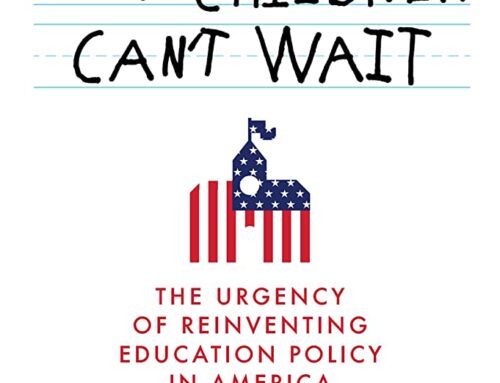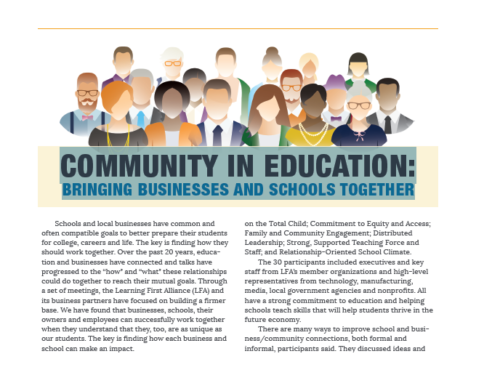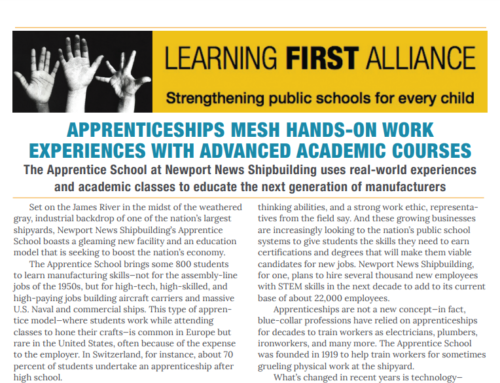We know how to provide world-class education in the United States. In many places, it has been—and is being—done. Public elementary, middle and high school students across the country are building robots and 3D-generated artificial limbs; creating original works of art; collaborating with local government officials to solve community problems; and integrating technology as they write poems and business proposals. Their schools are fulfilling what many consider the purpose of education: developing young people’s knowledge, skills and attitudes so that they graduate from high school ready for college, career and citizenship.
Where schools are working, it is because educators, parents and local communities have developed programs specific to meet their goals and challenges. However, there are elements common to all successful schools. Based on a review of seminal documents from our member organizations that reflect their expertise and experience in public schooling, the Learning First Alliance has identified them—six elements around which successful schools are organized, whether formally or informally, that each impact several important aspects of schooling.
But we want to make clear that the “solution” in improvement isn’t the same for every school. How these elements are implemented and integrated depends greatly on context. Each school has a wide range of existing strengths and a unique set of needs. And each child in each school is different. Therefore, schools combine the elements necessary for success in very different ways.
These elements are:
Focus on the Total Child
Successful schools support all students’ needs, inside and outside the classroom, to help them become effective, empowered learners. They design and carry out programs that offer all students a rich educational experience, supporting their academic and social/emotional learning so they develop the skills needed to succeed in an ever-changing environment. These schools customize learning to individual students, taking advantage of advances in technology as they do so. They also provide opportunities for students to explore careers and nurture their talents and interests, including through partnerships with their communities.
Commitment to Equity and Access
Successful schools ensure all students have access to high-quality services and supports enabling them to set and reach high goals for learning. In them, equity does not mean equality; they recognize some students need additional resources to have the same opportunity for success as others. They ensure the needs of all student populations are met, including English language learners, students with disabilities, children of color, religious minorities, LGBTQ students and others. Successful schools recognize such students are assets and diversity is a strength.
Family and Community Engagement
Successful schools effectively engage families and communities in support of students. In doing so, they identify barriers to such engagement and work to overcome them. Their efforts to build authentic connections to families are centered on a belief that every parent wants the best for their child and, when provided the right invitations and opportunities, they can help their child, and all children, be successful.
Distributed Leadership
Successful schools define leadership broadly. Leadership is distributed—to principals, teachers, school counselors, community members and others in the building—and decision-making is a shared endeavor. In these schools, leaders (regardless of job title) meet high standards of practice and are supported in their development. They understand that effective communications is a critical component of school success, and they build solid, trusting relationships with both school and community stakeholders.
Strong, Supported Teaching Force and Staff
Successful schools are staffed with educators—including teachers, principals, school counselors, technology specialists and others—who are well-educated, well-prepared and well-supported. These educators meet high standards of practice. They benefit from continuous learning and support along the professional continuum, including through high-quality pre-service education, ongoing high-quality professional learning, meaningful evaluation tied to professional growth and opportunities to take on leadership roles regardless of official title.
Relationship-Oriented School Climate
Successful schools create a culture of collaboration and shared responsibility among staff and students and with families and communities. These schools are safe, welcoming and respectful to all. They establish teaching and learning as core values. They support positive behavior and build healthy, supportive relationships and a sense of community both between and among students and staff. In them, students have frequent opportunities for participation, collaboration, service and self-direction, strengthening their connection to the school.
Moving Toward Success
Schools are exciting places to be. They teem with life wrapped around the hope and obstacles that each child faces. Yet there are challenges that exist within them, as well as controversy of how to “fix” them.
Here we described the six big elements that are part of successful schools. Most have been explored in other papers, so in a sense, we aren’t offering anything new. However, two things make this piece unique.
One is consensus. This document does not reflect the expertise of one individual or one organization. Rather, it reflects the collective wisdom of all the various public school stakeholders. Together, they agree these are the elements needed for a school to perform at a high level.
The second is that it isn’t the individual elements; it is interactions. A school with good teachers and poor leadership won’t be successful. Nor will a school with strong leadership and poor teachers. The interaction between all six of these elements is critical. It is the bonds between these elements that allow the successful school to form. We must work together to ensure each school has what it needs to get there.

Download the compendium, the executive summary or the two-page brief.




